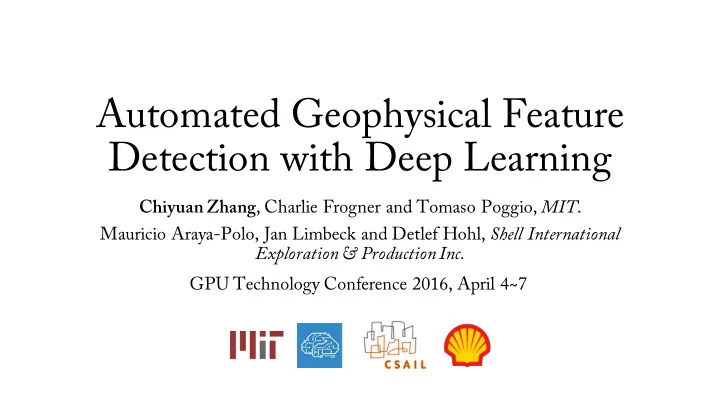

Automated Geophysical Feature Detection with Deep Learning Chiyuan Zhang , Charlie Frogner and Tomaso Poggio, MIT . Mauricio Araya-Polo, Jan Limbeck and Detlef Hohl, Shell International Exploration & Production Inc . GPU Technology Conference 2016, April 4~7
Motivation Motivation ↔ Methods ↔ Results
Motivation: Seismic Exploration • Seismic exploration before drilling a well (very expensive) Upstream. Seismic data are of crucial importance in the oil and gas industry. They are used in the exploration phase to find deep hydrocarbon accumulations , and during various phases of oil and gas field development planning to characterize the field before and during production.
Seismic Survey Workflow Seismic traces Data acquisition, on/off shore. waveforms (time series) indexed by shot id and receiver id Data processing: iterations could take multiple months with human experts.
Automated Geophysical Feature Detection Step 2: Feedback loop & Iterations Geophysical Features & Structures Step 1: Interpretation & Modeling
Automated Geophysical Feature Detection Early stages feature Step 2: Feedback loop & Iterations detection can help to steer the interpretation & modeling process. Geophysical Features & Structures Step 1: Interpretation & Modeling
Automated Geophysical Feature Detection From raw seismic traces , discover ( classification ) and locate ( structured Seismic Survey prediction ) faults in the underground structure, before running migration / interpretation. Machine Learning
Methods Motivation ↔ Methods ↔ Results
Machine Learning based Fault Detection Challenge Solution ❶ Unlike simple classification, the output Wasserstein-loss based structured output space is structured. learning. ❷ The mapping from traces to location of Using deep neural networks for modeling. faults is a very complex nonlinear function. ❸ DNNs need a lot of training data. Generate random synthesized training data (geological/geophysical model design + physical simulation + generative probabilistic modeling) ❹ Computational issue. Julia + GPUcomputation with NVidia CUDA.
Learning with Wasserstein Loss • The machine learning task • Classification & structured-output prediction • Wasserstein-loss [FZMAP15] to enforce smoothness in the output space • Difference between object-detection like tasks in computer vision: • Input (time-series at different sensor location) and output (spatial map) live in different domain. • Time-location correspondence is unknown until full migration / interpretation is done. FZMAP15: C. Frogner*, C. Zhang*, H. Mobahi, M. Araya-Polo, T. Poggio. Learning with a Wasserstein Loss. NIPS 2015.
Deep Learning based Fault Detection GPU Parallel Computing CPU Asynchronized Stochastic Gradient Data IO Data Descent Solver Scheduling Warehouse MIT Julia NVidia cuDNN Deep Neural Networks
Synthesizing Training Data Synthesize Random Velocity Models Simulate Wave-propagation & Collect Seismic Traces Generate Ground- truth Fault Location
Deep Generative Models / 3D Modeling Image from http://www.pdgm.com/products/skua-gocad/geophysics/skua- Image from Alec Radford, Luke Metzand Soumith Chintala, 2016. gocad-velocity-modeling/
Deep Learning on GPUs hidden_layers = map(1:n_hidden_layer) do i InnerProductLayer(name="ip$i", output_dim=n_units_hidden, bottoms=[i == 1 ? :data : symbol("ip$(i-1)")], tops=[symbol("ip$i")], weight_cons=L2Cons(10), neuron = neuron == :relu ? Neurons.ReLU() : Neurons.Sigmoid()) end pred_layer = InnerProductLayer(name="pred", output_dim=n_class, tops=[:pred], bottoms=[symbol("ip$n_hidden_layer")]) loss_layer = WassersteinLossLayer(bottoms=[:predsoft, :label]) backend = use_gpu ? GPUBackend() : CPUBackend() libcudaRT libcuBLAS method = SGD() libcuRAND params = make_solver_parameters(method) libcuDNN solver = Solver(method, params)
Summary of Challenges & Solutions ❸ ❷ Deep Neural Data Networks Warehouse Multi-layer dense layers Mocha.jl Julia-based deep learning toolkit ❶ ❹ Computation Wasserstein Loss Backends Loss function with semantic smoothness CPU, GPU (cuDNN)
Results Motivation ↔ Methods ↔ Results
Results: Plots, single fault Test case: 10k models, 510k traces, SGD 250k iterations. No noise, 1 fault , no salt body, downsample 64 . DNN arch: 4 layers,1024 neurons Prediction accuracy: • Area under Curve (AUC): 77 % • Intersection over Union (IOU): 71 %
Results: Plots, multiple faults Test case: 10k models, 510k traces, SGD 250k iterations. No noise, 2 faults , no salt body, downsample 8 . DNN arch: 4 layer, 768 neurons Prediction accuracy: • Area under Curve (AUC): 86% • Intersection over Union (IOU): 75%
Results: Plots, salt bodies Test case: 10k models, 510k traces, SGD 250k iterations. No noise, 1 fault , Salt body , downsample 8 . DNN arch: 2, 256 Prediction accuracy: • Area under Curve (AUC): 96 % • Intersection over Union (IOU): 74 %
Results: Computation Performance • Performance plots, test case 10k models (80/20 split) 768 neurons 4 layers • CPU vs GPU: for the same reference architecture our GPU (1 chip of a K80) implementation is 38x faster than the CPU one (1 Haswell E5-2680, 12 cores) • Multi-GPU . We are collaborating with BitFusion (booth 731) to get this feature at Mocha level, so then transparent for our architectures
Results: Visualization • more visualization, different cases, with & without salt body, different downsampling, etc. • We can also show Wasserstein vs standard loss if we have the visualization results
Summary • Deep-learning based system for automate geophysical feature detection from pre-migrated raw data. • Generative model + physical simulation of wave propagation for synthesized training data. • Wasserstein-loss for structured output learning problems. • GPU-accelerated computation for fast modeling.
Recommend
More recommend